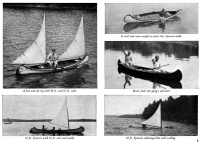The Boston Chapter of the Appalachian Mountain Club (AMC) was famous for decades for lashing two 6'x2" planks of ethafoam under the inwales on both insides of their whitewater open canoes. Maybe they still do. This was in addition to end flotation bags.
The purpose of the side flotation is to float the canoe higher when capsized, which reduces pin/wrap danger in rapids, and to make it easier to remove more water from the canoe when flipping it over for a paddler re-entry. The side flotation also makes it easier to drain water out of your canoe simply by heeling it over to the rail when inside the canoe.
These last two benefits also apply for side flotation in a flat water canoe. But ethafoam planks are heavy. Side flotation bags aren't. Here are two videos that demonstrate side flotation bag use.
This first video shows a canoe with a side float bag installed on only one side of the canoe, which demonstrates how the side float bag can reduce water intake when flipping a capsized canoe, even when just doing a roll flip rather than an aerial (Capistrano) flip.
This second video shows Greg Spencer in the Lake District of England re-entering and sitting on the rails of a 14'x30" solo canoe equipped with side float bags on each side. Note that he can get the canoe almost completely dry with his well-practiced Capistrano flip technique. This is difficult to do with a heavy canoe and with a canoe not having adequate end flotation, and is made easier to do with the lightweight side flotation.
I know @Alan Gage has experimented with solo re-entry into canoes with different types of end flotation, but perhaps not with side flotation.
The purpose of the side flotation is to float the canoe higher when capsized, which reduces pin/wrap danger in rapids, and to make it easier to remove more water from the canoe when flipping it over for a paddler re-entry. The side flotation also makes it easier to drain water out of your canoe simply by heeling it over to the rail when inside the canoe.
These last two benefits also apply for side flotation in a flat water canoe. But ethafoam planks are heavy. Side flotation bags aren't. Here are two videos that demonstrate side flotation bag use.
This first video shows a canoe with a side float bag installed on only one side of the canoe, which demonstrates how the side float bag can reduce water intake when flipping a capsized canoe, even when just doing a roll flip rather than an aerial (Capistrano) flip.
This second video shows Greg Spencer in the Lake District of England re-entering and sitting on the rails of a 14'x30" solo canoe equipped with side float bags on each side. Note that he can get the canoe almost completely dry with his well-practiced Capistrano flip technique. This is difficult to do with a heavy canoe and with a canoe not having adequate end flotation, and is made easier to do with the lightweight side flotation.
I know @Alan Gage has experimented with solo re-entry into canoes with different types of end flotation, but perhaps not with side flotation.

